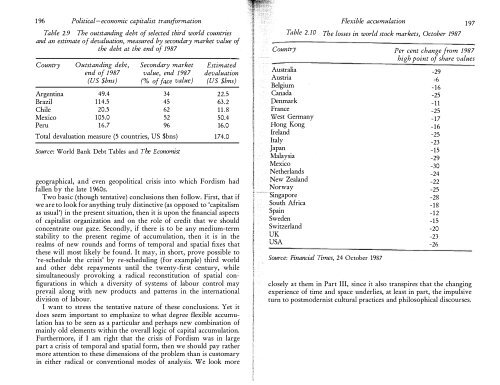..194 Political-economic capitalist transformationordinary efflorescence and transformation in financial markets (seefigures 2.12, 2.<strong>13</strong>, and 2.14). <strong>The</strong>re have been phases <strong>of</strong> capitalisthistory - from 1890 to 1929, for example - when 'finance capital'(however defined) seemed to occupy a position <strong>of</strong> paramount importancewithin capitalism, only to lose that position in the speculativecrashes that followed. In the present phase, however, it is notso much the concentration <strong>of</strong> power in financial institutioI;lS thatmatters, as the explosion in new financial instruments and markets,coupled with the rise <strong>of</strong> highly sophisticated systems <strong>of</strong> financial coordinationon a global scale. It is through this financial system thatmuch <strong>of</strong> the geographical and temporal flexibility <strong>of</strong> capital accumulationhas been achieved. <strong>The</strong> nation state, though seriously weakenedas an <strong>autonomous</strong> power, nevertheless retains important powers <strong>of</strong>labour disciplining as well as <strong>of</strong> intervention in financial flows andmarkets, while becoming itself much more vulnerable to fiscal crisisand the discipline <strong>of</strong> international money. I am therefore tempted tosee the flexibility achieved in production, labour markets, and consumptionmore as an outcome <strong>of</strong> the search for financial solutions tothe crisis-tendencies <strong>of</strong> capitalism, rather than the other way round.This would imply that the financial system has achieved a degree <strong>of</strong>autonomy from real production unprecedented in capitalism's history,carrying capitalism into an era <strong>of</strong> equally unprecedented financialdangers.<strong>The</strong> emphasis on financial and monetary solutions derives, <strong>of</strong>course, from the inflationary rather than deflationary nature <strong>of</strong> theway the crisis was manifest from the mid-1960s on. What is surprisingis the way in which indebtedness and fictitious capital formationhave accelerated since then, at the same time as massivedefaults and devaluations have been absorbed, not without trauma tobe sure, within the financial apparatus <strong>of</strong> overall regulation (seefigures 2.12 and 2.<strong>13</strong>). In the United States, for example, the bankingsystem went into the red, for the first time since 1934, in the firsthalf <strong>of</strong> 1987 with scarcely a murmur <strong>of</strong> panic. <strong>The</strong> pace <strong>of</strong> bankfailures has likewise picked up dramatically since 1980 (figure 2.14).And we need only take the secondary market value <strong>of</strong> third worlddebt, and multiply it by the obligations outstanding, to get a roughestimate <strong>of</strong> the volume <strong>of</strong> devaluation current within the financialsystem (see figure 2.16 and table 2.9). Compared to all <strong>of</strong> this, theextraordinary fluctuations manifest in stock and currency marketsappear more as epiphemonena rather than as fundamental structuralproblems.It is tempting, <strong>of</strong> course, to see this all as some prelude to afinancial crash that would make 1929 look like a footnote in history.807060504030Brazil20 Peru. ... . . . . . . ...",--_/ .. ,...,Mexico • "_ . . - . . ..." -'" " .,10 ..% 0J A S a NFlexible accumulationD ' J. .1987 1988F,y '. - " -.. .M A M J J. .• • • ArgentinaFigure 2.16 <strong>The</strong> changing secondary market value <strong>of</strong> the debt obligations <strong>of</strong>selected countries(Source: <strong>The</strong> Economist)While it would be foolish to rule that out as a very real possibility,particularly in the light <strong>of</strong> the heavy losses in world stock markets inOctober 1987 (see table 2.10), circumstances do indeed appear radicallydifferent this time around. Consumer, corporate, and governmentaldebts are much more tightly tied in with each other (figure2.<strong>13</strong>), permitting the simultaneous regulation <strong>of</strong> both consumptionand production magnitudes through speculative and fictitious financing.It is also much easier to deploy strategies <strong>of</strong> temporal and geographicaldisplacement together with sectoral change under the hegemonicumbrella <strong>of</strong> burgeoning financial markets. Innovation within thefinancial systems appears to have been a necessary prerequisite toovercoming the general rigidities as well as the distinctive temporal,AS195
196 Political-economic capitalist transformationTable 2.9 <strong>The</strong> outstanding debt <strong>of</strong> selected third world countriesand an estimate <strong>of</strong> devaluation, measured by secondary market value <strong>of</strong>the debt at the end <strong>of</strong> 1987CountryOutstanding debt,end <strong>of</strong> 1987(US $bns)Argentina 49.4Brazil 114.5Chile 20.5Mexico 105.0Peru 16.7Secondary marketvalue, end 1987(% <strong>of</strong> fa.ce value)3445625296Total devaluation measure (5 countries, US $bns)Source: World Bank Debt Tables and <strong>The</strong> EconomistEstimateddevaluation(US $bns)22.563.211.850.416.0174.0geographical, and even geopolitical crisis into which Fordism hadfallen by the late 1960s.Two basic (though tentative) conclusions then follow. First, that ifwe are to look for anything truly distinctive (as opposed to 'capitalismas usual') in the present situation, then it is upon the financial aspects<strong>of</strong> capitalist organization and on the role <strong>of</strong> credit that we shouldconcentrate our gaze. Secondly, if there is to be any medium-termstability to the present regime <strong>of</strong> accumulation, then it is in therealms <strong>of</strong> new rounds and forms <strong>of</strong> temporal and spatial fixes thatthese will most likely be found. It may, in short, prove possible toere-schedule the crisis' by re-scheduling (for example) third worldand other debt repayments until the twenty-first century, whilesimultaneously provoking a radical reconstitution <strong>of</strong> spatial configurationsin which a diversity <strong>of</strong> systems <strong>of</strong> labour control mayprevail along with new products and patterns in the internationaldivision <strong>of</strong> labour.I want to stress the tentative nature <strong>of</strong> these conclusions. Yet itdoes seem important to emphasize to what degree flexible accumulationhas to be seen as a particular and perhaps new combination <strong>of</strong>mainly old elements within the overall logic <strong>of</strong> capital accumulation.Furthermore, if I am right that the crisis <strong>of</strong> Fordism was in largepart a crisis <strong>of</strong> temporal and spatial form, then we should pay rathermore attention to these dimensions <strong>of</strong> the problem than is customaryin either radical or conventional modes <strong>of</strong> analysis. We look moreCountryTable 2.10AustraliaAustriaBelgiumCanadaDenmarkFranceWest GermanyHong KongIrelandItalyJapanMalaysiaMexicoNetherlandsNew ZealandNorwaySingaporeSouth AfricaSpainSwedenSwitzerlandUKUSAFlexible accumulation 197<strong>The</strong> losses in world stock markets, October 1987Source: Financial Times, 24 October 1987Per cent change from 1987high point <strong>of</strong> share values-29-6-16-25-11-25-17-16-25-23-15-29-30-24-22-25-28-18-12-15-20-23-26closely at them in Part III, since it also transpires that the changingexperience <strong>of</strong> time and space underlies, at least in part, the impulsiveturn to postmodernist cultural practices and philosophical discourses.
















